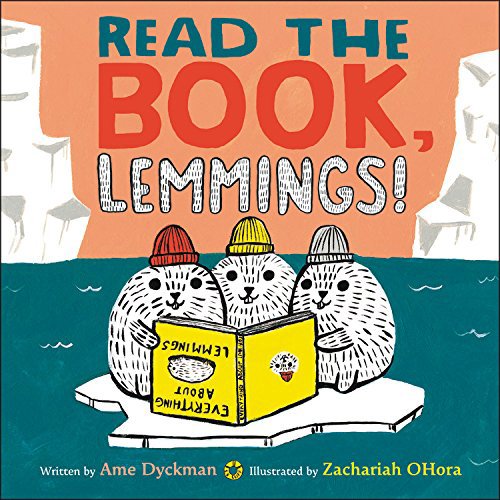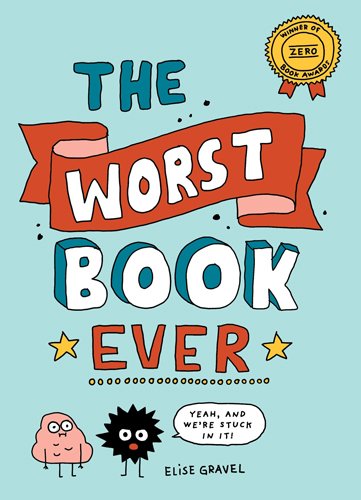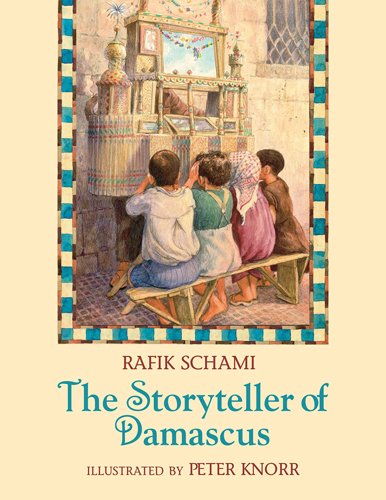Today’s Stack Overflow contains books about stories: about the joy of reading, the magic of words, the unreliability of narrators, the allure of a good book.
Mousie, I Will Read to You written by Rachael Cole, illustrated by Melissa Crowton
This lovely picture book is about raising a reader: the mama mouse reads to her baby “long before the words make sense,” but as time passes and Mousie grows up, the mama continues to read and share words. Mousie starts making noises, then words, then short sentences. He starts to pick out books for himself at the library, and then begins to read—words at first, then sentences, then whole books. And eventually … he has a baby of his own, and gets to read stories to his own child. I love the way that books and words are woven into various different scenes from Mousie’s life. At the end of the book, there’s also a note about “Raising a Reader” with some tips about how to read to kids!
The Night Library written by David Zeltser, illustrated by Raul Colón
A young boy, excited for his 8th birthday, is disappointed when his parents give him a book as a gift. But that night, he is woken by a lion outside his window, and is taken to the New York Public Library, where the two library lions—Patience and Fortitude—remind him of the books that his grandpa used to read to him, and show him how reading can reconnect him with those memories of his grandpa. It’s a little bit like The Polar Express, but for the love of reading instead of Santa Claus, and I love the illustrations of the books, come to life to reenact the stories they contain.
Book or Bell? written by Chris Barton, illustrated by Ashley Spires
Henry has just discovered an amazing book—but he keeps getting interrupted by the school bell. This time, though, he decides to just ignore the bell and keep reading … which causes a series of ridiculous accidents due to his absence. The mayor, governor, and senator propose their solutions: even louder bells! But Henry just keeps on reading anyway. It’s a very silly book, but it’s a fun way to show how captivating a good book can be sometimes.
Read the Book, Lemmings! written by Ame Dyckman, illustrated by Zacharaiah OHora
Lemmings, of course, are known for jumping off cliffs—except that a lot of that is actually a misconception, as it turns out. Foxy knows that they don’t jump off cliffs because he’s reading a book about lemmings. The lemmings, however, have not read the book, and they keep jumping to conclusions … and into the water. Will the lemmings finally read the book? Will they stop jumping off the ship? Read the book, lemmings!
A Cooked-Up Fairy Tale written by Penny Parker Klostermann, illustrated by Ben Mantle
I’ve always enjoyed twists on classic fairy tales. In this book, William doesn’t really fit into the land of fairy tales—he’s more interested in whipping up a tasty dish. When he finds a box of apples, beans, and a pumpkin intended for delivery to Fairy-Tale Headquarters, he decides to create some scrumptious foods with those ingredients … but the characters in Snow White, Jack and the Beanstalk, and Cinderella aren’t really sure how these delicious dishes fit into their stories. Still, everyone manages to get their happily ever afters… even William.
Lyric McKerrigan, Secret Librarian written by Jacob Sager Weinstein, illustrated by Vera Brosgol
Who’s got the perfect book for every situation? Lyric McKerrigan, Secret Librarian! When the evil Doctor Glockenspiel escapes from prison and threatens to destroy all of the world’s books if his ransom isn’t paid, Lyric McKerrigan is on the job. She infiltrates Doctor Glockenspiel’s secret lair and gets past all his defenses using—what else?—books, passed along to various henchmen and security guards. It’s a celebration of how books can distract, educate, and enchant us. Plus it’s just a really fun read, with wonderful illustrations.
The Book Hog by Greg Pizzoli
The Book Hog loves books. He collects them anywhere he can find them … but his secret is that he can’t actually read them. One day, though, he comes across a library, and when the librarian offers to read books with him, he can’t believe his luck! By the end of the story, the Book Hog has learned to read and still loves to collect books, but now he loves them for what’s inside them, not just the way they feel and smell. (But, let’s be honest: they feel and smell great, too, right?)
Snappsy the Alligator and His Best Friend Forever! (Probably) written by Julie Falatko, illustrated by Tim Miller
The narrator of this book is, as it turns out, Bert the chicken, who has declared himself Snappsy’s best friend forever. But Snappsy disagrees with the narration. Snappsy wants to go out (alone) and buy some vegetables, maybe check out the new smoothie shop. But Bert is planning a sleepover with matching T-shirts, lots of snacks, and karaoke. Of course, this is one of those stories where eventually when Bert leaves and Snappsy finally has his home to himself, he realizes he misses Bert after all and they do indeed have a fun time together—one of my pet peeves—but the back-and-forth between the narration and Snappsy is pretty amusing, and illustrates how you can’t always trust everything you see just because it’s printed on the page.
Dragons Eat Noodles on Tuesdays written by Jon Stahl, illustrated by Tadgh Bentley
And in another story about questionable narrators, this book features two strange monsters telling stories. The blue monster tries to tell a very, very short story, but the yellow monster points out that it’s not so great: it’s too short, and you can’t tell a kids’ story where a kid gets eaten by a dragon. So it takes over, and tells a much more exciting story (which comes to life in the pictures). But what happens when the story about the dragon spills over into the story about the two monsters? It’s a clever book that blurs the boundaries between the framing story and the story-within-the-story.
The Worst Book Ever by Elise Gravel
Here’s another book with little creatures giving meta-commentary about the story they’re in. On the left side, there’s a fairy tale-ish story about a princess and a prince and a big monster. On the right side, there’s a pink lump, a black spiky ball, and a spider who talk about what’s going on: they comment on spelling mistakes, ugly drawings, repetitive sentences, sexism, product placement, and so on. Elise Gravel has managed to cram a host of problems into one short book, and then points them all out for the reader. It’s cute and funny, but it also helps readers to be more explicitly aware of the messages we’re presented with in other stories, which I think is a valuable lesson.
The Happy Book (and other feelings) by Andy Rash
Camper and Clam are both happy: a happy camper and happy as a clam. They live in the Happy Book, where everything is happy … until Camper eats the entire friendship cake. Then Clam heads off into the Sad Book, hanging out with his friend Trombone (“Bwah-bwah”). Camper doesn’t understand why Clam wants to hang out there at all, so he heads to yet another book: the Angry Book. Each “book” has its own color scheme and a character, as Camper and Clam figure out their feelings and finally manage to communicate with each other. The book is done in a comic book style, with frames and dialogue balloons, and I like the way that the characters find doorways from the “endpapers” of one book into the next book as they travel.
The Storyteller of Damascus written by Rafik Schami, illustrated by Peter Knorr
I have to admit: when I first saw this book, I thought it was just going to be an illustrated version of an old story, the sort that we keep around because we have some nostalgia for it but it wasn’t going to be exciting enough for “kids these days.” It has that look to it: the illustrations have borders that look like tapestries, the pages are cream-colored (like the cover), and there’s a LOT of text. But—like the kids in the story itself—I was in for a surprise.
The storyteller is an old man who carries a large chest on his back. The chest has little peepholes, and inside are wonderful illustrations of the stories he tells, about a poor shepherd boy named Sami who is clever and lucky and always manages to overcome all the people who try to get in his way. It’s really a series of traditional-sounding stories, and the first telling takes more than half of the book.
But then we cut back to the framing story, and we see that the city has modernized. Our narrator tells us that the old pictures had faded, and the storyteller had to find new pictures. This time, the pictures from before are repeated—but they’re faded and worn, and have been pasted over with photographs, ads cut out from magazines, and so on. The evil gang leader rides off in a jeep instead of on a horse. The stories have adapted to fit the new pictures.
The framing story also addresses the way that the kids start losing interest in the stories they’ve heard all their lives, but it ends on a note that celebrates the power of good storytelling—whether there are pictures or not, a good story can enchant us and take us on a magical journey.
Before They Were Authors: Famous Authors as Kids by Elizabeth Haide
This is a picture book but made in a sort of comic-book format, featuring 10 different famous authors and stories about them when they were kids. Each one gets five pages: one splash page with a portrait and a brief timeline, and then four more pages with panels that give a quick overview of their life—both as kids and as adults. The book isn’t just meant to tell kids about authors, though: it’s meant to inspire kids to become writers themselves. Haide shares the authors’ own thoughts about what it’s like to write, where they get inspiration, and so on.
 Chapter Two Is Missing! written by Josh Lieb, illustrated by Kevin Cornell
Chapter Two Is Missing! written by Josh Lieb, illustrated by Kevin Cornell
This book isn’t out until October, but I just had to go ahead and include it now. I got an advance galley for it, and it’s fantastic. The narrator of this book (the kid seen on the cover) has discovered that Chapter 2 is gone. The book just goes from Chapter 1 to Chapter 3, with a two-page spread between them where you can just make out some faint traces of words. There’s a detective on the case, but that pesky janitor keeps getting in the way, leaving piles of Ms in one chapter for them to trip over, or borrowing punctuation from the narrator. If you love books with characters who know they’re in a book, you’ll get a kick out of this one for sure.
My Current Stack
I’ve been a bit remiss in writing Stack Overflow columns lately. May has been a blur—we’re starting to experience some of the end-of-school-year rush, and it just feels like I’ve had a string of unexpected appointments to drive my kids to. I’m still working my way through Binti by Nnedi Okorafor, and have been enjoying that a lot. I’ve also read a couple kids’ comic books, including the third book in the 5 Worlds series by Mark Siegel et al., The Red Maze. More about that one soon, I hope!
In time for Walt Whitman’s 200th birthday this past week, I read Live Oak, With Moss, a collection of his poems illustrated by Brian Selznick. You can actually read a preview at that link there. The story is that Live Oak, With Moss is a series of a dozen poems that Whitman had written, his reflections on his love for other men, as well as what it’s like to drift apart. These poems were never published during his lifetime, though he cut them up and rearranged them in Leaves of Grass. His notebook was later found and the poems reassembled. This edition of the book features the poems as a centerpiece, surrounded by Selznick’s illustrations that he calls a “framework, or a lens, through which they can be discovered.” The back of the book includes an in-depth commentary by Dr. Karen Karbiener as well. The illustrations are beautiful and evocative, and the book itself is lovely, with gilded edges and a deep red cover.
Finally, I picked up a copy of the first hardcover collection of The Wicked + the Divine by Kieron Gillen and Jamie McKelvie et al. at the bookstore. I had intended to just flip through it one evening before bed but ended up reading the whole thing. I’d seen various volumes at the store quite often over the years but never really looked into it. The premise is that every 90 years, 12 gods (from various cultures) reappear, inhabiting the bodies of young people. And then, two years later, they die. The world of the story includes a lot of pop culture that has been built around the Pantheon—people study the phenomenon academically, there are conventions, but this is the first recurrence in the modern age, and this time the Pantheon are like rock stars. The book reminds me slightly of American Gods, in the way that it pulls from various religions and puts those beings in modern England. On top of that, it’s also a bit of a murder mystery. I’ll probably check out the next volume soon.
A note about the links: For a while I’ve been using Amazon links in my Stack Overflow columns—if you click through and buy a book from there, I get a small commission, which helps me earn a little with my writing. However, lately I’m feeling more and more that driving business to Amazon, although it’s convenient, also supports a lot of practices that I disagree with. If you don’t have a local bookstore and online stores are one of the only ways for you to purchase books, then I’m glad they exist. But otherwise, I encourage you to patronize independent booksellers and your local library! From now on, I’ll be linking to WorldCat, which can then link you to local libraries that have a copy of the book. Happy reading!
Disclosure: Except where otherwise explained, I received review copies of the books in this column.

















